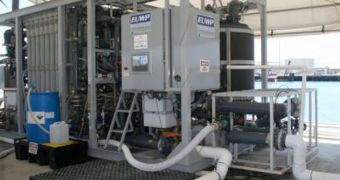The US Navy's Office of Naval Research (ONR) is one of the leading promoters of innovation in the United States, a role that it recently reaffirmed when it created a new technique for producing freshwater out of seawater. The method is twice more efficient than current ones, and will offer a much-needed production boost at sea, for Marine Corps expeditionary forces, as well as for humanitarian missions ashore.
“Saving energy and producing clean water is a tactical issue for the Navy. We plan to build prototype desalination units that will use 65 percent less energy and be 40 percent smaller by weight and by volume relative to current Navy reverse osmosis systems. They should require roughly 75 percent less maintenance,” says ONR program officer Dr J. Paul Armistead, who has a deep interest in water purification technologies. The new research was done under the Expeditionary Unit Water Purification Program (EUWP), which was initiated back in 2004.
Most US Navy ships and sailors currently benefit from high-tech, Reverse Osmosis (RO) desalinization plant, as opposed to having to refuel for freshwater in ports, or to collect it from rain and then store it. However, the process of making seawater drinkable is very energy-consuming, and the EUWP was initiated precisely to find solutions around this problem. There are numerous advantages to having more efficient water-production capabilities, including extended ship ranges, reduced fuel consumption, and a smaller environmental footprint, the ONR argues.
“Several of the projects we have funded have turned into patents for commercially available products and processes that are available for use in water desalination systems for communities where freshwater sources are not available,” says US Bureau of Reclamation physical scientist Michelle Chapman, who is also a member of the ONR team managing the research program. She notes that the ONR's efforts have also been set to good use for civilian applications as well.
“Any sort of technology advancements we find for ships are directly applicable ashore and can be utilized by ever-increasing drought ridden areas,” adds Navy Surface Warfare Center Carderock Division, Ship Systems Engineering Station (NSWCCD-SSES) mechanical engineer Dave Nordham. Key partners in the EUWP program include NSWCCD-Philadelphia, the US Army Tank Automotive Research Development and Engineering Command, the US Bureau of Reclamation, and the Naval Facilities Engineering Service Center's Seawater Desalination Test Facility, in Port Hueneme, California.

 14 DAY TRIAL //
14 DAY TRIAL //